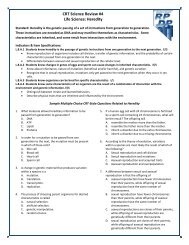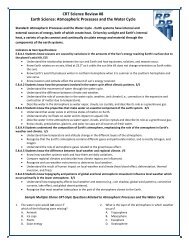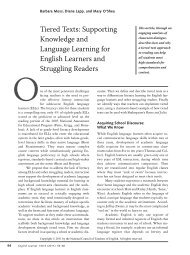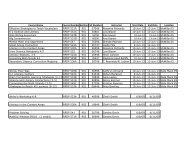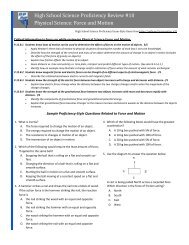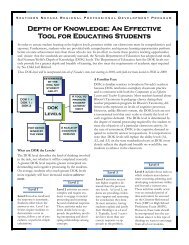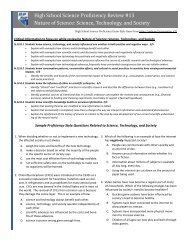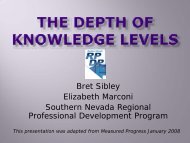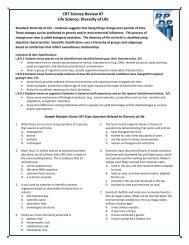Science Achievement Indicators Grade 6-8 - RPDP
Science Achievement Indicators Grade 6-8 - RPDP
Science Achievement Indicators Grade 6-8 - RPDP
Create successful ePaper yourself
Turn your PDF publications into a flip-book with our unique Google optimized e-Paper software.
<strong>Achievement</strong> <strong>Indicators</strong> for <strong>Science</strong><br />
<strong>Grade</strong>s 6-8<br />
Content Standard L8B (continued)<br />
Students understand that living things are composed of cells, which are specialized in multi cellular organisms to perform a variety of life functions.<br />
Content Benchmarks<br />
Work at the Emergent/<br />
Developing level may indicate<br />
ability to...<br />
Work at the Approaches level<br />
may indicate ability to…<br />
Work at the Meets level<br />
demonstrates ability to…<br />
L.8.B.4 Students know cells<br />
combine to form tissues that<br />
combine to form organs and<br />
organ systems that are<br />
specialized to perform life<br />
functions.<br />
identify the following human<br />
organ systems: muscular,<br />
skeletal, circulatory, reparatory,<br />
nervous, and digestive system.<br />
(L.8.B.4)<br />
explain that tissues are<br />
composed of cells working<br />
together. (L.8.B.4)<br />
explain that organs are<br />
composed of tissues which<br />
work together. (L.8.B.4)<br />
explain that organ systems<br />
consist of organs working<br />
together. (L.8.B.4)<br />
Work at the Exceeds level<br />
demonstrates ability to…<br />
describe the basic functions of<br />
the following human organ<br />
systems: muscular, skeletal,<br />
circulatory, respiratory,<br />
nervous, and digestive system.<br />
(L.8.B.4)<br />
L.8.B.5 Students know disease<br />
can result from defects in body<br />
systems or from damage caused<br />
by infection.<br />
recognize that living organisms<br />
get diseases. (L.8.B.5)<br />
recognition that not all diseases<br />
are infectious. (L.8.B.5)<br />
explain that diseases occur<br />
when there is breakdown in the<br />
structure or function of a body<br />
system. (L.8.B.5)<br />
describe how a disease disrupts<br />
the homeostasis of an organism.<br />
(L.8.B.5)<br />
give examples of diseases that<br />
are inherited and diseases that<br />
are infectious. (L.8.B.5)<br />
August 2007 14





